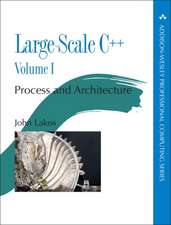PASCAL-XSC: Language Reference with Examples
Autor Rudi Klatte Traducere de G. F. Corliss Autor Ulrich Kulisch Traducere de R. Klatte Autor Michael Neaga Traducere de U. Kulisch Autor Dietmar Ratz Traducere de D. Ratz Autor Christian Ullrich Traducere de C. Wolffen Limba Engleză Paperback – 28 feb 1992
Preț: 337.32 lei
Preț vechi: 421.66 lei
-20% Nou
Puncte Express: 506
Preț estimativ în valută:
64.55€ • 67.70$ • 53.73£
64.55€ • 67.70$ • 53.73£
Carte tipărită la comandă
Livrare economică 01-15 aprilie
Preluare comenzi: 021 569.72.76
Specificații
ISBN-13: 9783540551379
ISBN-10: 3540551379
Pagini: 348
Ilustrații: X, 344 p.
Dimensiuni: 170 x 242 x 18 mm
Greutate: 0.55 kg
Ediția:Softcover reprint of the original 1st ed. 1992
Editura: Springer Berlin, Heidelberg
Colecția Springer
Locul publicării:Berlin, Heidelberg, Germany
ISBN-10: 3540551379
Pagini: 348
Ilustrații: X, 344 p.
Dimensiuni: 170 x 242 x 18 mm
Greutate: 0.55 kg
Ediția:Softcover reprint of the original 1st ed. 1992
Editura: Springer Berlin, Heidelberg
Colecția Springer
Locul publicării:Berlin, Heidelberg, Germany
Public țintă
GraduateCuprins
1 Introduction.- 1.1 Typography.- 1.2 Historical Remarks and Motivation.- 1.3 Advanced Computer Arithmetic.- 1.4 Connection with Programming Languages.- 1.5 Survey of PASCAL-XSC.- 2 Language Reference.- 2.1 Basic Symbols.- 2.2 Identifiers.- 2.3 Constants, Types, and Variables.- 2.4 Expressions.- 2.5 Statements.- 2.6 Program Structure.- 2.7 Subroutines.- 2.8 Modules.- 2.9 String Handling and Text Processing.- 2.10 How to Use Dynamic Arrays.- 3 The Arithmetic Modules.- 3.1 The Module C_ARI.- 3.2 The Module I_ARI.- 3.3 The Module CI_ARI.- 3.4 The Module MV_ARI.- 3.5 The Module MVC_ARI.- 3.6 The Module MVI_ARI.- 3.7 The Module MVCI_ARI.- 3.8 The Hierarchy of the Arithmetic Modules.- 3.9 A Complete Sample Program.- 4 Problem-Solving Routines.- 5 Exercises with Solutions.- 5.1 Test of Representability.- 5.2 Summation of Exponential Series.- 5.3 Influence of Rounding Errors.- 5.4 Scalar Product.- 5.5 Boothroyd/Dekker Matrices.- 5.6 Complex Functions.- 5.7 Surface Area of a Parallelepiped.- 5.8 Parallelism and Intersection of Lines.- 5.9 Transposed Matrix, Symmetry.- 5.10 Rail Route Map.- 5.11 Inventory Lists.- 5.12 Complex Numbers and Polar Representation.- 5.13 Complex Division.- 5.14 Electric Circuit.- 5.15 Alternating Current Measuring Bridge.- 5.16 Optical Lens.- 5.17 Interval Evaluation of a Polynomial.- 5.18 Calculations for Interval Matrices.- 5.19 Differentiation Arithmetic.- 5.20 Newton’s Method with Automatic Differentiation.- 5.21 Measurement of Time.- 5.22 Iterative Method.- 5.23 Trace of a Product Matrix.- 5.24 Calculator for Polynomials.- 5.25 Interval Newton Method.- 5.26 Runge-Kutta Method.- 5.27 Rational Arithmetic.- 5.28 Evaluation of Polynomials.- A Syntax Diagrams.- B Indices and Lists.- B.1 Syntax Diagrams.- B.2 Reserved Words.- B.3 PredefinedIdentifiers.- B.4 Operators.- B.4.1 Basic Operators.- B.4.2 Arithmetic Operators.- B.4.3 Relational Operators for the Arithmetic Types.- B.4.4 Assignment Operators.- B.5 Predefined Functions.- B.6 Transfer Functions.- B.7 Predefined Procedures.- B.8 #-Expressions.- B.8.1 Real and Complex #-Expressions.- B.8.2 Real and Complex Interval #-Expressions.








